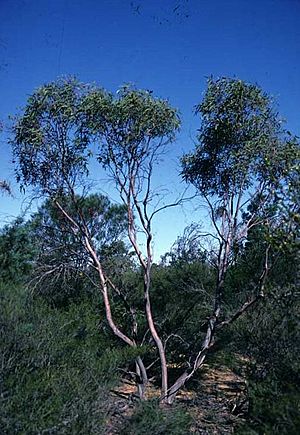Beard's mallee facts for kids
Quick facts for kids Beard's mallee |
|
|---|---|
 |
|
| Eucalyptus beardiana growing in the North Murchison | |
| Conservation status | |
| Scientific classification | |
| Genus: |
Eucalyptus
|
| Species: |
beardiana
|
Beard's mallee (scientific name: Eucalyptus beardiana) is a special type of eucalyptus tree. It's called a 'mallee' because it has many stems growing from the ground, instead of just one trunk. This plant is endemic to Western Australia, which means it naturally grows only in that area.
This unique plant has smooth bark that can be pinkish, grey, or cream. Its adult leaves are long and narrow, often curved. The flowers are pale yellow and usually grow in groups of nine. After the flowers, it grows round, woody fruits that point downwards.
Contents
What is Beard's Mallee Like?
Beard's mallee is a spreading plant that usually grows about 3 to 5 meters (10 to 16 feet) tall. It has a special woody swelling underground called a lignotuber. This helps the plant regrow after things like bushfires.
The bark on its stems and branches is smooth. It can be grey, cream, or even pinkish in color.
Leaves of the Mallee
Young plants and new shoots have dull, narrow leaves. These leaves are about 2 to 9 centimeters (0.8 to 3.5 inches) long and 0.5 to 3.5 centimeters (0.2 to 1.4 inches) wide. They have a small stalk called a petiole.
Adult leaves are a bit different. They are shaped like a spear or are slightly curved. They are usually 7.5 to 13 centimeters (3 to 5 inches) long and 0.7 to 1.5 centimeters (0.3 to 0.6 inches) wide. These leaves also have a petiole, which is about 1 to 2.3 centimeters (0.4 to 0.9 inches) long.
Flowers and Fruit
The flowers of Beard's mallee usually grow in groups of nine, but sometimes there are eleven. These groups grow from the axils (the spot where a leaf joins the stem). Each group is on a stalk called a peduncle, which is about 2 to 3 centimeters (0.8 to 1.2 inches) long. Each individual flower sits on a smaller stalk called a pedicel, about 1.2 to 1.4 centimeters (0.5 inches) long.
Before they open, the flower buds are oval-shaped. They are about 1.9 to 2.2 centimeters (0.7 to 0.9 inches) long and 0.7 to 0.9 centimeters (0.3 to 0.4 inches) wide. The top part of the bud, called the operculum, is finely beaked and about 1.4 centimeters (0.6 inches) long.
Beard's mallee mainly flowers from August to September. The flowers are a pale yellow or creamy white color. After flowering, the plant produces a woody, round fruit. This fruit is called a capsule. It is about 0.7 to 1 centimeter (0.3 to 0.4 inches) long and 0.9 to 1.3 centimeters (0.4 to 0.5 inches) wide. It has a slightly flared rim.
How it Got its Name
Eucalyptus beardiana was first officially described in 1978. Two scientists, Ian Brooker and Donald Blaxell, wrote about it in a scientific journal called Nuytsia. They found a sample of the plant near Shark Bay.
The second part of its name, beardiana, was chosen to honor John Stanley Beard. He was a botanist who spent a long time studying plants in Western Australia. The scientists thought it was a good way to remember his important work.
Where Beard's Mallee Lives
Beard's mallee grows in areas with tree heath and tall, open shrubland. It often grows alongside other plants like Yuna mallee, Mallalie, Eucalyptus gittinsii, sceptre banksia, Ashby's banksia, and broom honey-myrtle. You can also find it with different types of Acacia, Grevillea, and Persoonia plants.
This plant is found on sandy plains. Its natural home is between the Murchison River and Shark Bay in Western Australia.
Protecting Beard's Mallee
Beard's mallee is considered "endangered" by the Australian Government. This means it is at a high risk of disappearing from the wild. The Department of Environment and Conservation (Western Australia) also lists it as "Threatened Flora."
The biggest dangers to Beard's mallee are:
- Habitat disturbance: This happens when its living areas are disturbed. For example, when firebreaks or tracks are made.
- Grazing animals: Animals eating the plants can harm them.
- Weed invasion: Weeds can grow and take over the space and resources that Beard's mallee needs.
Images for kids





